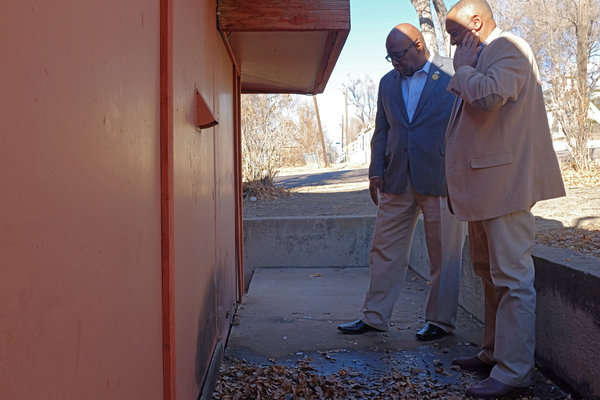
SCORCH MARKS AND QUESTONS LINGER AFTER N.A.A.C.P. BOMBING IN COLORADO
Jack Healdy
Henry D. Allen Jr., president of the Colorado Springs chapter of the N.A.A.C.P., left, showed James Simmons, a fellow member, the site of the bombing on the side of the building. Credit Matthew Staver for The New York Times
COLORADO SPRINGS — A shadow of char is the only remnant of an improvised bomb that exploded Tuesday outside the local offices of the N.A.A.C.P. here at the feet of the snow-covered Rocky Mountains, jolting the volunteers more accustomed to running membership drives and planning prayer breakfasts.
On Thursday, F.B.I. investigators continued trying to unravel the identity and motivation of whoever had set off the makeshift bomb Tuesday morning, a crime that authorities are investigating as a possible bias attack or case of domestic terrorism. The N.A.A.C.P.’s all-volunteer staff here decided to reopen the office, still baffled by an assault that they said seemed to come out of nowhere.
“It really saddens me,” said Henry D. Allen Jr., the president of the group’s Colorado Springs chapter. “I do look at the ’50s and ’60s when there were bombings, there were lynchings,” he said. And now, he added, “when those who say that civil rights is no longer an issue, we’re going back to that destructive mentality. I tell them the fight is still on.”
The group has long been active in local civil-rights issues related to policing and education, and it held candlelit vigils for Trayvon Martin and Michael Brown, both of them African-American teenagers who were shot dead by white men. But for the most part, members said, their perch here in a one-story red building sharing space with a hair salon seemed a world away from the protests over racially charged police killings that have shaken American cities in recent months.
“It’s just astounding to see that somebody would go through all that trouble to hurt somebody who gives turkeys at Thanksgiving,” said Carol Chippey-Rhanes, a volunteer.
The building is tucked into a residential neighborhood on the south side of town, two blocks away from a school that offered its space as a meeting place after the explosion. The chapter has been in the same building for about 30 years, its presence announced by a simple light-blue sign above the front door.
“We’ve been here forever,” Mr. Allen said.
Amy E. Sanders, an F.B.I. spokeswoman in Denver, said it was still unclear whether the N.A.A.C.P. had been targeted, and said the agency was investigating “all possibilities for motive.” Law enforcement officials have said they are looking for a “person of interest” they described as a middle-age, balding white man driving a white pickup truck, but have said nothing else about their search for a suspect.
The F.B.I. said the improvised explosive was detonated at 10:45 a.m. Tuesday and had been placed next to a gasoline can, which did not ignite. No one was hurt, and the damage was limited to scorching on the outside of the building.
Since the bombing, two volunteers said their thoughts turned to a tense encounter shortly before Christmas, when an angry man had walked into their offices and delivered a disjointed tirade about how the N.A.A.C.P. was not supporting his personal protest against local law enforcement. Volunteers listened to him, and then asked him to leave. They said they reported the interaction to the authorities after the bombing, but had no idea whether there was any connection. Ms. Sanders declined to comment on the incident.
By Thursday morning, volunteers were back at their desks in the small office, making coffee and answering nonstop phone calls: Thank you, we are all doing O.K. A supporter dropped off trays of vegetables and pastries, as well as three bottles of sparkling juice. The president of the group’s Wyoming chapter drove down to offer support and help answer phones. Mr. Allen, the Colorado Springs chapter president, was busy talking to concerned neighbors and coordinating events for Black History Month with two soldiers from a nearby Army base.
The local chapter has been active here in Colorado Springs — which is also home to the N.A.A.C.P.’s state conference — since about 1920. The chapter has spent the past couple of years trying to re-energize itself, Mr. Allen said, increasing its membership from 269 to more than 500 and reaching out to the area’s large Spanish-speaking population.
“We are law-abiding citizens,” Mr. Allen said. “We are not a radical, out-of-control group. We just want everybody to be treated equally.”
On Tuesday morning, Mr. Allen said he and his wife were having their car washed when he received a call from his assistant telling him there had been an explosion. At first, he said, he thought he did not hear her right. Members said they were still waiting for answers from investigators and said they felt shaken.
“I’m not sure this isn’t part of a bigger polarization that’s occurring across the country — a spinoff of Ferguson and what happened in New York,” said Willie Breazell, a former chapter president. “I’m just concerned that this will continue to escalate.”
For years, Mr. Breazell said, the group had resisted putting security cameras outside the building, but now he thought it was time for a change. As he sat on a sunny bench outside the building, he pointed to eaves and niches where they could install cameras to keep track of who came and went.
“I think it’s time for it,” he said.

